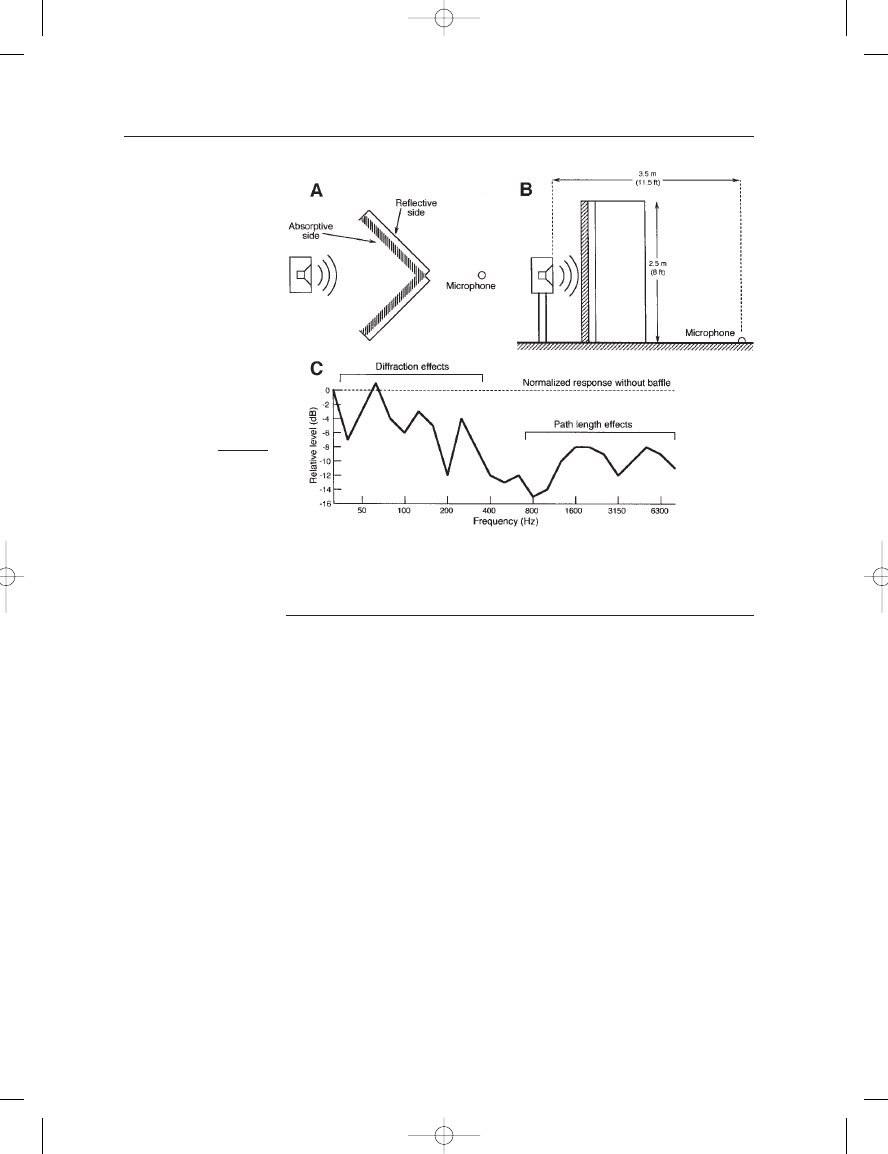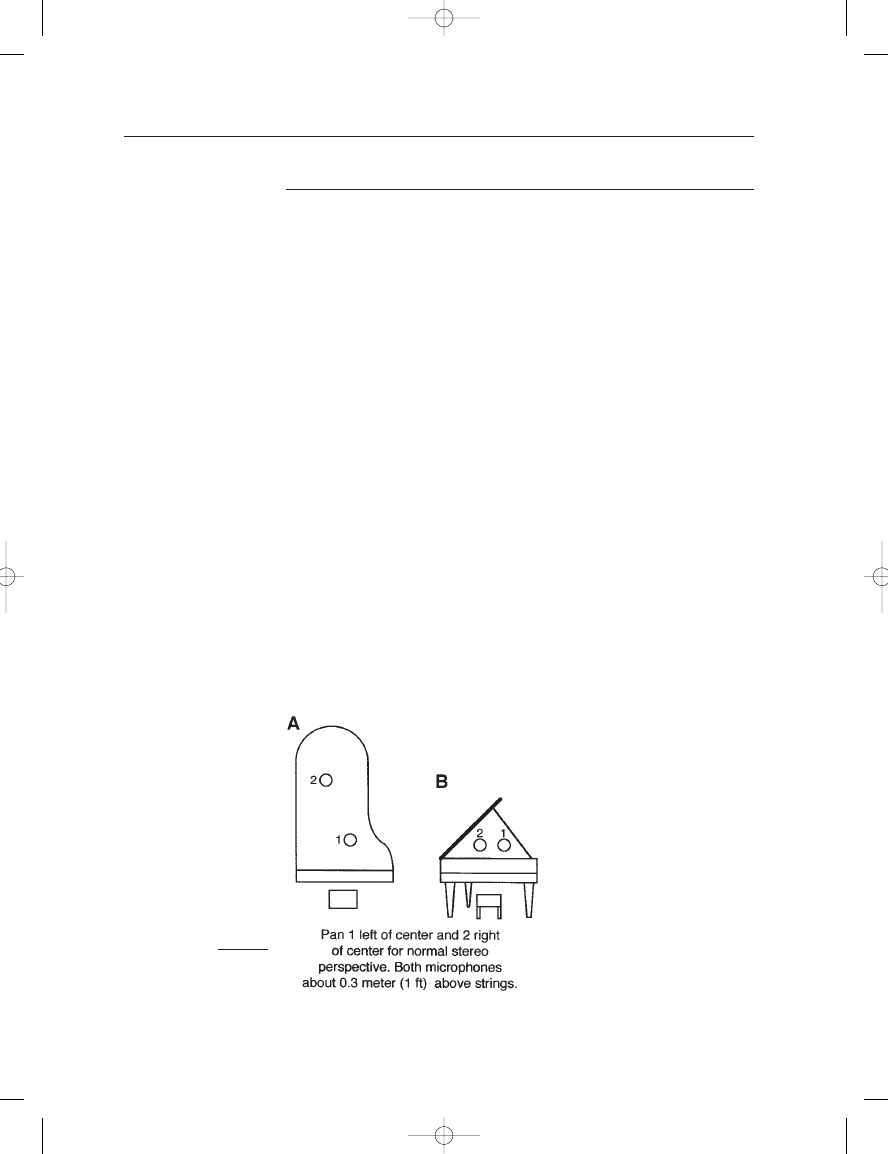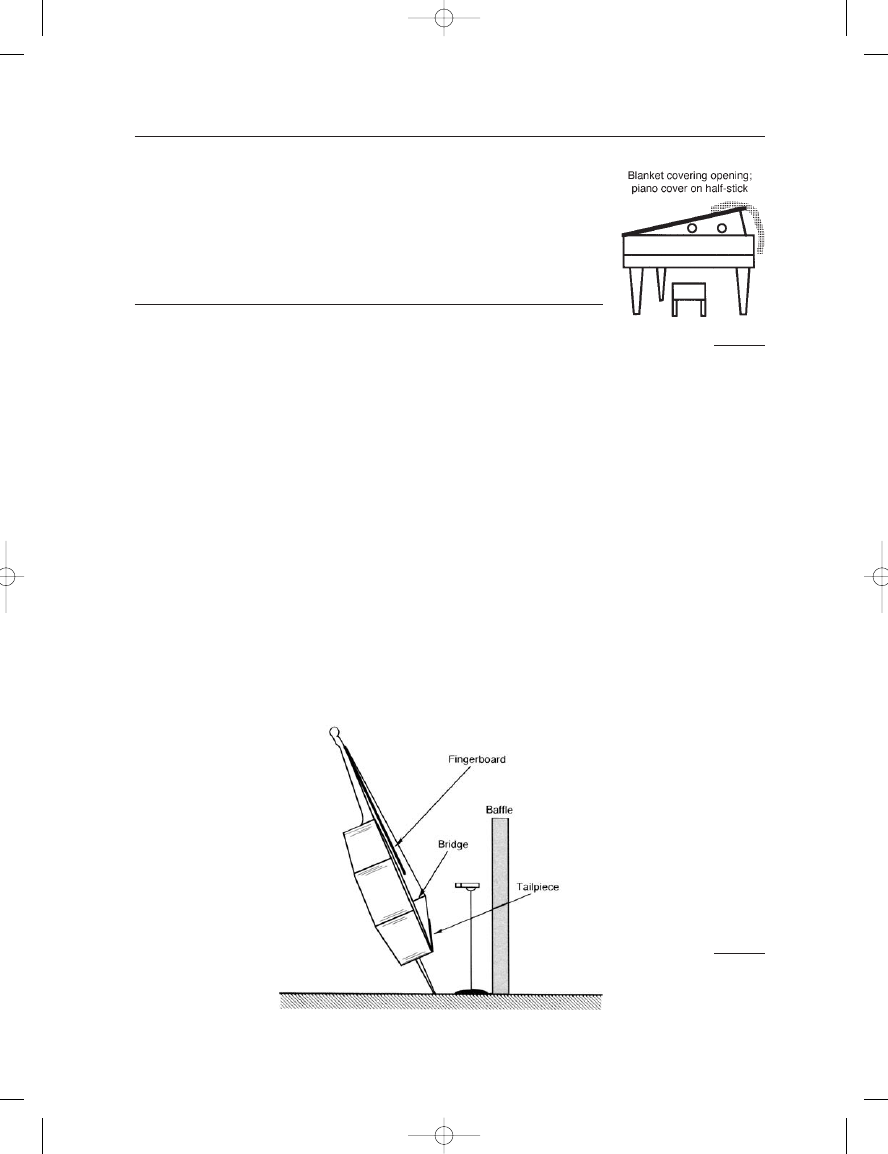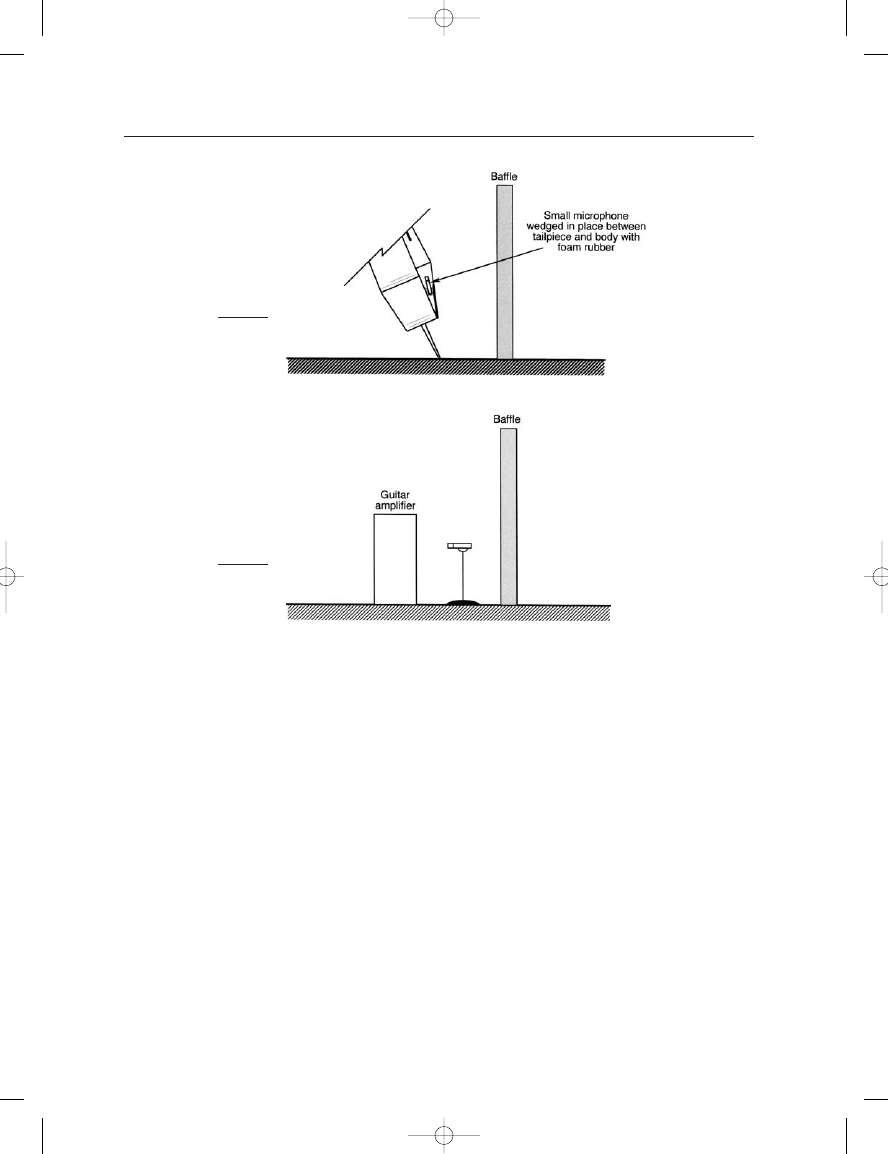ВУЗ: Казахская Национальная Академия Искусств им. Т. Жургенова
Категория: Книга
Дисциплина: Не указана
Добавлен: 03.02.2019
Просмотров: 17292
Скачиваний: 51

RECORDING OTHER PERCUSSION INSTRUMENTS
There are more percussion instruments than we can hope to detail here;
however, they all fall into several basic groups, according to the principle
of sound generation:
The non-pitched percussion instruments include:
●
Metallophones (metal resonators):
Triangle (struck with a small metallic beater)
Gongs and tam-tams (struck with soft beaters)
Finger cymbals (struck together)
Bell tree (graduated set of nested bells, usually struck in succession
with metal beater)
Cocolo (small metal chains loosely positioned around a metal
core that is rotated by the player)
●
Xylophones (non-metallic resonators):
Maracas (dried gourds filled with seeds and shaken)
Castanets (small wood-against-wood pieces shaken together)
Claves (hard wood sticks struck together)
Guiro (dried gourd with serrations; played with scraper)
●
Membranophones (instruments with stretched diaphragms):
Bongo drums (set of Latin drums roughly tuned high to low)
14: Studio Recording Techniques
223
FIGURE 14–7
Effectiveness of baffles:
top view (A); side view
(B); isolation versus
frequency (C).
Earg_14.qxd 14/9/04 2:54 PM Page 223

Tambourine (combination of metallophone and membranophone)
Other ethnic drums
The pitched percussion instruments include:
●
Metallophones:
Orchestra bells (set of metal bars in keyboard layout)
Chimes (suspended tubular bells in keyboard layout)
Celesta (tuned metal bars played with keyboard)
Vibraphone (tuned metal bars played with mallets)
●
Xylophones (generic):
Xylophone (short tuned wooden bars in keyboard layout)
Marimba (tuned wooden bars with resonators in keyboard
layout)
The smaller percussion instruments are normally played by two or
three musicians, who move freely from instrument to instrument as
called for in the musical score. It is best to record them in stereo with
good left-to-right spread, assigning them to one or more stereo pairs of
recorded tracks. For example, a Latin work with might call for a signifi-
cant marimba part to be recorded in stereo, while another stereo pair of
tracks will be assigned to a group of non-tuned percussion instruments.
Normally the microphone would be about 0.5–1 m (20–40 in) away
from the instruments. Recording the vibraphone in stereo is shown in
Figure 14–8. The same setup applies to the marimba and other tuned
mallet instruments.
THE MICROPHONE BOOK
224
FIGURE 14–8
A widely splayed pair of
cardioids for recording the
vibraphone in stereo.
Earg_14.qxd 14/9/04 2:54 PM Page 224

RECORDING THE PIANO
The piano is invariably picked up in stereo using two or three microphones.
Typical placement for pop/rock recording is shown in Figure 14–9.
In a jazz context the microphones would normally be placed slightly
outside the rim of the instrument, giving just a bit more distance to the
instrument.
When picked up at such short distances the piano may sound quite
bright, and the hammers may have to be softened by a piano technician.
Any slight mechanical problem may become very apparent with close
microphone placement, and the technician should be prepared to fix such
problems. Keep in mind that any changes made to the hammers (hard-
ening or softening) cannot always be undone easily or quickly. The tech-
nician and player should be in agreement on any changes made to the
instrument.
Most engineers favor cardioid microphones for close placement,
since the proximity LF rise will usually enhance the sound of instrument.
Microphones placed outside the rim may be omnidirectional or cardioid,
at the choice of the engineer or producer. Some engineers prefer to use
boundary layer microphones, fastening them to the underside of the
piano cover using double-sided tape. This minimizes the effect of reflec-
tions inside the instrument.
As an aid to minimizing studio leakage into the piano microphones,
many engineers position the piano so that its cover, when open, faces
away from the other players, thus shielding the instrument from direct
sounds in the studio. If more isolation is required, the piano cover may
be positioned on “half-stick” and a blanket placed over the opening, as
shown in Figure 14–10.
14: Studio Recording Techniques
225
FIGURE 14–9
Recording the piano: top
view (A); front view (B).
Earg_14.qxd 14/9/04 2:54 PM Page 225

While the basic piano tracks should be recorded dry, reverberation
will always be added in postproduction. The presentation on the stereo
soundstage is normally in stereo; however, if the mix is a hard-driving,
complex one, the piano may sound clearer if mixed to mono and posi-
tioned where desired.
RECORDING THE ACOUSTIC BASS
There are several methods for recording the bass:
1. Microphone on a floor stand
2. Nesting a microphone behind the tailpiece of the instrument
3. Microphone at bass amplifier/loudspeaker unit
4. Direct-output from instrument pickup into the console
Using a floor stand, as shown in Figure 14–11, a cardioid microphone
can be precisely placed to pick up the desired combination of fundamen-
tal sound along with the sounds of the player’s fingers on the strings. For
acoustical jazz it is important to achieve this, and we recommend this
approach as the best overall choice. It may be helpful to place a set of 1 m
(40 in) high baffles behind the microphone to reduce leakage from other
instruments.
Some engineers prefer to place a small format omnidirectional
microphone in the space between the tailpiece and the body of the instru-
ment. It is usually wedged in place using a piece of foam rubber, as
shown in Figure 14–12. The advantage as here is that any movements of
the instrument will not alter the microphone-to-instrument distance; a
disadvantage is that the pickup of finger articulation will be minimized.
THE MICROPHONE BOOK
226
FIGURE 14–10
Recording the piano with
added isolation.
FIGURE 14–11
Recording the bass
with a stand-mounted
microphone.
Earg_14.qxd 14/9/04 2:54 PM Page 226

Under some adverse conditions the engineer will have no other
recourse than to place a microphone directly in front of the loudspeaker
in the bass amplifier/loudspeaker unit, as shown in Figure 14–13. Many
times, a quick stage setup or change-over will not provide the time nec-
essary to work out the details of a better pickup method. Many bass
amplifiers are noisy and may be distorted at high output levels, both of
which can cause problems in postproduction. However, if the amp is
clean and noise-free, you can get a good recording this way.
A direct console feed from the instrument’s pickup is an excellent
way to achieve a good bass sound with no leakage whatever. Be sure that
you have a good active splitter box that will allow you to sample the sig-
nal directly out of the bass, while sending an uninterrupted signal on to
the bass amplifier. Details are shown in Figure 14–14A and B. Most
direct output feeds are unbalanced (see Chapter 8 under Microphone
Splitters) and should be fed into a console input set for line input opera-
tion. Phantom powering should be turned off.
Given the choice, most engineers will want to lay down at least two
bass tracks, one direct and the other via a microphone pickup. The two
will often be combined in postproduction. (Be on the lookout for anti-
phase cancellation when the signals are combined later on.)
14: Studio Recording Techniques
227
FIGURE 14–12
Recording the bass with a
microphone mounted on
the instrument.
FIGURE 14–13
Picking up the bass
acoustically from the bass
amplifier.
Earg_14.qxd 14/9/04 2:55 PM Page 227